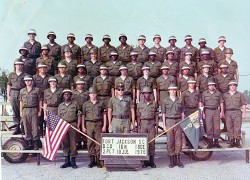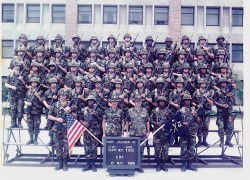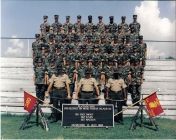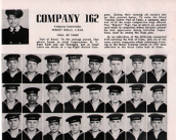A Firefinder Radar Operator is crucial to the Army's field artillery radar team. 'Firefinder' is the name given to highly specialized machines that detect mortars, planes and other objects by using radio or sound waves to determine their location. The Firefinder Radar Operator uses radar to detect opposing forces and alert units in the Army.
13R1O - Skill Level One




Firefinder Radar Operator: Establishes and maintains radio and wire communications. Prepares for operation, and operates and maintains firefinder radar’s (AN/TPQ-36 or AN/TPQ-37) and associated equipment. Constructs fortifications, bunkers, and crew‑served weapons emplacements. Operates and performs operator maintenance on prime movers, radar system, and associated equipment.
13R2O - Skill Level Two

Senior Firefinder Radar Operator: Leads and supervises the preparation for operations and operates and maintains firefinder radar’s. Assists section chief in controlling soldiers and equipment also provides technical guidance to lower grade soldiers. Takes part in the reconnaissance and selection of site for emplacement of radar. Supervises and schedules operational maintenance on radar and associated equipment. In the absence of the section chief, assumes the duties of the section chief.
13R3O - Skill Level Three

Section Chief: Leads and supervises the combat operation of firefinder mortar locating radar’s. Leads, trains, and supervises soldiers in operation and maintenance of radar and associated equipment. Provides leadership and training for integrated target acquisition operations. Instructs soldiers in radar operation, techniques, and procedures. Leads and supervises unit maintenance on firefinder radar and ancillary equipment, and operator maintenance on organic communications equipment and vehicles. Evaluates, processes, and reports target information to Battalion. Recommends positioning of direct support target acquisition radar assets, sectors of search, and radar zone positioning. Recommends cueing guidance to Bn/Divarty counterfire officer for weapon locating radar’s.
13R4O - Skill Level Four

Platoon Sergeant: The platoon sergeant is the primary assistant and advisor to the platoon leader with the responsibility of training and caring for soldiers. The platoon sergeant helps the commander to train the platoon leader and in that regard has an enormous effect on how that young officer perceives NCOs for the rest of his career. The platoon sergeant takes charge of the platoon in the absence of the platoon leader. As the lowest level senior NCO involved in the battery METL, platoon sergeants teach collective and individual tasks to soldiers in their sections or equivalent small units. A platoon sergeant or sergeant first class generally has extensive military experience and can make accurate decisions in the best interest of the mission and the soldier. Utilizing tough, realistic and intellectually and physically challenging performance-oriented training to excite and motivate soldiers, the platoon sergeant ensures Army standards are met and maintained. Additionally, the platoon sergeant must conduct cross training to promote critical wartime skills within the unit, evaluate the effectiveness of the platoon and provide training feedback to the commander and first sergeant during After-Action Reviews (AAR) on all unit collective training.
Senior FA Targeting NCO: Leads and supervises the combat operations of radar platoons. Leads soldiers performing duties of FA firefinder radar operator. Conducts map and ground reconnaissance of general position areas for relocation of weapons locating radar. Coordinates survey data. Ensures radar visibility diagrams are constructed correctly for posting on battery capabilities chart. Conducts, coordinates, and evaluates platoon training. Leads, supervises, and trains the targeting element in a Tactical Operations Center in conjunction with the Fire Support Element (FSE). Collects and disseminates intelligence information and applies these products to the tactical employment of TA assets and counterfire operations. Assist in monitoring target acquisition assets operations, status, and current and proposed locations. Recommends TA coverage to include command and control relationships of organic and attached TA assets. Provides input to Divarty S-2 for consolidation into the Target Acquisition Tab. Recommends the positioning of General Support TA assets, sector of search, and radar zone positioning. Prepares Radar Deployment Orders (RDO) as required. Assists in maintaining the artillery OB Data Base and target file. Recommends cueing guidance to the S-2 for all Division TA assets. Assists in preparing the Target Acquisition Tab of the FA Support Plan. Coordinates logistics requirements and prepares reports summarizing data obtained from radar sections on troop strengths, logistics, surveillance techniques, and tactical operations.
School: 061 School Location: FT SILL, OK
Course Title: FA FIREFINDER RADAR OPERATOR
FY: 2009 School: 061 Course: 221-13R10 Phase: Course Length: 8 Weeks 0.0 Days
Verifiable Prerequisites Prerequiste Item Value(s) or Range Constraint PULHES 222221 Required
Normal Red/Green (RG) Perception YES Required
Physical Demand Rating HEAVY - LIFT OCCASIONAL 100 LB, FREQUENT 50 LB Required
Male Gender Requirement YES Required
Must be a U.S. Citizen YES Required
Course Security Clearance Y - NONE Required
ASVAB SC Score 098 Required
Prerequisite Courses
There are no Prerequisite Courses.
Text Prerequisites
Qualifying scores.
(a) A minimum score of 100 in aptitude area SC in Armed Services Vocational aptitude Battery (ASVAB) tests administered prior to 2 January 2002.
(b) A minimum score of 98 in aptitude area SC on ASVAB tests administered on and after 2 January 2002.
Active Army and Reserve Component Army and USMC enlisted personnel.
Course Scope:
Operations, communication procedures; IFSAS interface; radar registrations; use of SINCGARS equipment; preventive maintenance on the radars and ancillary equipment.
Special Information:
There is no Special Information.
Senior FA Targeting NCO: Leads and supervises the combat operations of radar platoons. Leads soldiers performing duties of FA firefinder radar operator. Conducts map and ground reconnaissance of general position areas for relocation of weapons locating radar. Coordinates survey data. Ensures radar visibility diagrams are constructed correctly for posting on battery capabilities chart. Conducts, coordinates, and evaluates platoon training. Leads, supervises, and trains the targeting element in a Tactical Operations Center in conjunction with the Fire Support Element (FSE). Collects and disseminates intelligence information and applies these products to the tactical employment of TA assets and counterfire operations. Assist in monitoring target acquisition assets operations, status, and current and proposed locations. Recommends TA coverage to include command and control relationships of organic and attached TA assets. Provides input to Divarty S-2 for consolidation into the Target Acquisition Tab. Recommends the positioning of General Support TA assets, sector of search, and radar zone positioning. Prepares Radar Deployment Orders (RDO) as required. Assists in maintaining the artillery OB Data Base and target file. Recommends cueing guidance to the S-2 for all Division TA assets. Assists in preparing the Target Acquisition Tab of the FA Support Plan. Coordinates logistics requirements and prepares reports summarizing data obtained from radar sections on troop strengths, logistics, surveillance techniques, and tactical operations.
School Information

Field Artillery Center/School, Fort Sill, OK
School: 061 School Location: FT SILL, OK
Course Title: FA FIREFINDER RADAR OPERATOR
FY: 2009 School: 061 Course: 221-13R10 Phase: Course Length: 8 Weeks 0.0 Days
Verifiable Prerequisites Prerequiste Item Value(s) or Range Constraint PULHES 222221 Required
Normal Red/Green (RG) Perception YES Required
Physical Demand Rating HEAVY - LIFT OCCASIONAL 100 LB, FREQUENT 50 LB Required
Male Gender Requirement YES Required
Must be a U.S. Citizen YES Required
Course Security Clearance Y - NONE Required
ASVAB SC Score 098 Required
Prerequisite Courses
There are no Prerequisite Courses.
Text Prerequisites
Qualifying scores.
(a) A minimum score of 100 in aptitude area SC in Armed Services Vocational aptitude Battery (ASVAB) tests administered prior to 2 January 2002.
(b) A minimum score of 98 in aptitude area SC on ASVAB tests administered on and after 2 January 2002.
Active Army and Reserve Component Army and USMC enlisted personnel.
Course Scope:
Operations, communication procedures; IFSAS interface; radar registrations; use of SINCGARS equipment; preventive maintenance on the radars and ancillary equipment.
Special Information:
There is no Special Information.




